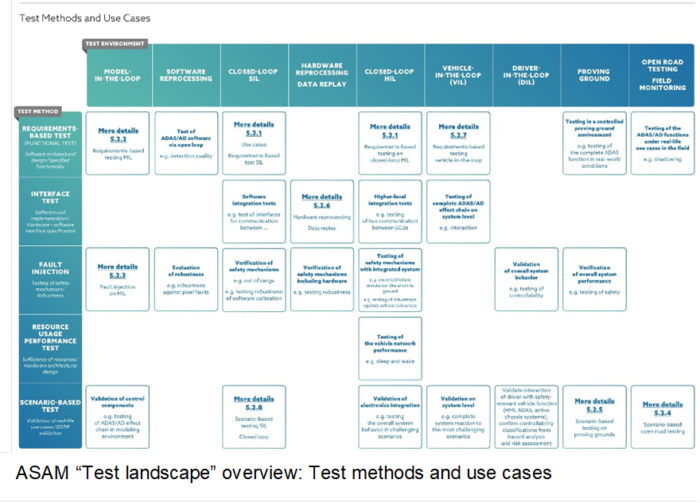ASAM has addressed the question of which test procedures are needed to make highly and fully automated driving safe, in a special report featuring the thoughts of experts and stakeholders from 24 organizations, including manufacturers, suppliers, testing companies and research institutes. ASAM hopes the report will provide a blueprint for validating autonomous vehicles and developing appropriate driving functions, safely and reliably.
The report notes that autonomous driving (AD) and advanced driver assistance systems (ADAS) require radical changes in testing methods and new concepts for comprehensive vehicle validation, both for physical and virtual testing. Without cooperation across manufacturers and sectors, and without intensive exchange among all stakeholders, it will not be possible to master this complexity. The use of standards to promote and enable exchange and collaboration is an integral part of meeting this challenge.
With this in mind, an interdisciplinary team of experts from 24 organizations around the world have contributed their knowledge to jointly answer questions such as: What is the state of the art in testing driving functions in a rapidly evolving environment? What are best practices for testing and safely deploying autonomous driving features? How can new technologies, such as artificial intelligence, be integrated? How can the industry deal with the fact that there are currently only a few legal requirements, but that in the future more or different requirements will decide on the homologation of vehicles?
The report from the ASAM Test Specification study group, which includes representatives from stakeholders such as manufacturers, suppliers, testing companies and research institutes, provides an overview of different test methods for ADAS and AD and their interaction. One outcome of the project was a ‘test strategy blueprint’ that can serve as a basis for future testing. As a holistic best practice approach, this blueprint can be tailored to the specific requirements of production and other projects while meeting current regulatory, legal and technical requirements. To develop the blueprint, the group identified detailed use cases for the implementation of a test strategy and aligned them with current standards and standardization initiatives. In the end, the project group derived recommendations for all stakeholders as well as suggestions for further standardization activities.
Benjamin Engel, chief technology officer at ASAM, commented, “When we look at ADAS and AD, we see that collaboration is extremely important. Standards are key if collaboration is to work. The ASAM Test Specification Report is also a call to the industry and other standardization organizations to further drive collaboration and make sure that we reach our common goal of highly automated driving, quickly and safely.“
“Safety is particularly important for software-centered vehicles as well as for autonomous driving functions,” added Jann-Eve Stavesand, project leader of the ASAM Test Specification study group and head of consulting at dSPACE GmbH. “To realize safe autonomous driving, many complex and demanding tests need to be performed. The members at ASAM believe that it is valuable and helpful to develop a complete test landscape for the automotive industry, a blueprint and a comprehensive overview of all test procedures that play an important role in the automotive industry.”
The report is aimed at all test and safety engineers involved in the validation of autonomous driving functions and highly automated driving, and all testing and homologation organizations that will be entrusted with the homologation of these functions in the future. It is freely accessible via the website report.asam.net.


